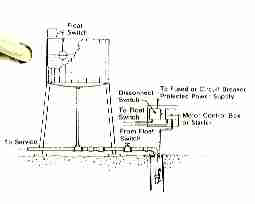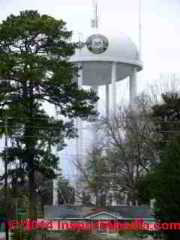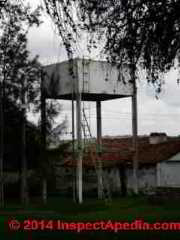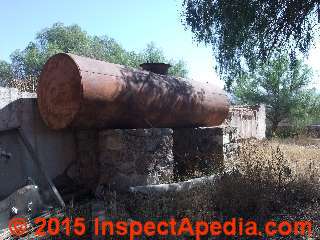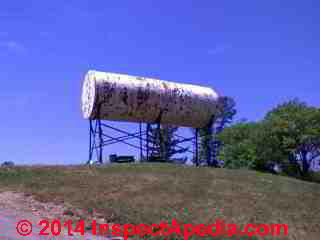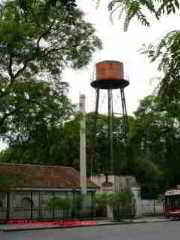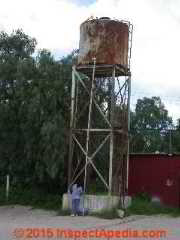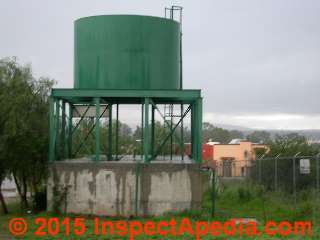 Water Storage Towers
Water Storage Towers
Types of water towers & above-ground water storage tanks
- POST a QUESTION or COMMENT about rooftop water towers used for water supply
Water towers & tower-mounted water storage tanks:
Water towers are widely used not just to store water but to deliver water at good pressure to a community of buildings and users. This article describes tower-mounted water storage tanks, where they are used, how they work, and the use of booster pumps to improve water pressure in buildings with water storage tanks.
We include water tower design considerations, codes and standard references & citations. We also discuss using a booster pump to improve building water pressure in buildings with weak municipal water pressure or the storage of water where water supply is limited or water replenishment is only seasonally available. Shown at page top: a hilltop water tower supplying the community of Atascadero in San Miguel de Allende, Guanajuato, Mexico.
InspectAPedia tolerates no conflicts of interest. We have no relationship with advertisers, products, or services discussed at this website.
- Daniel Friedman, Publisher/Editor/Author - See WHO ARE WE?
Large Water Storage Tanks on Towers or Free-standing Water Tanks at Ground Level
Elevated tower-supported water storage tanks are used both to store water and to provide water at pressure to individual buildings, building sites, or entire communities, as we illustrate in the photographs below.
At left is a sketch showing a traditional water storage tank on a tower connected to and located adjacent to a water well.
[Click to enlarge any image]
Below we illustrate water storage towers of several shapes and types and found in several locations and countries including in order: Brunswick Georgia (immediately below), U.S., The Taboada Hot Springs, Guanajuato, Mexico, and in the City of Buenos Aires, Argentina. Photos © Daniel Friedman.
Below: a water tower at the Taboada Hot Springs, Guanajuato, Mexico,
Design considerations for water storage tanks & their supporting towers
Above is a large above-ground water storage tank at Gogorron in San Luis Potosi, Mexico. This is a low tower supported on two large stone piers. Higher water towers need to meet wind and other loading specifications.
- Covering: to protect the stored water against contamination.
- Overflow handling: to direct overflow to ground level
Below we illustrate a horizontal cylindrical water storage tank at a damp in Dutchess County, New York in the U.S. This is an enclosed tank (there is not an overflow issue) fed by a pump from a local well at a camp.
- Circulation within the storage facility
- Gravity loads: the dead weight of materials of the water tower & storage tank construction
- Live Loads: the varying weight of water stored in the tank depending on the water level to which the tank is filled.
Below: a water tower in the City of Buenos Aires.
- Wind Loads: varying by terrain conditions and geographic area, water towers need to withstand loads from hurricanes, hilltop winds, confined areas creating a wind-tunnel effect.
The design engineer or architect for a water tower will consult a data source such as the International Building Code (IBC) where the code provides wind speed data at 30 feet above ground, and will add consideration for tower height, shape, location within local terrain, weather exposure (sun, snow, wind), etc.
For example a design wind speed of 80 mph translates to a surface pressure of 18 psf (0.00256 * the speed of the wind); tower designs need to allow for the maximum anticipated wind speed at the site. In coastal areas this may mean a wind speed allowance of 150 mph. - Fire code concerns: exposure to wild fires
- Enclosed non-residential towers vs. enclosed structures that may add heating requirements
- Access: for inspection, water tower interior cleaning, inspection & testing, maintenance, repair: ladders, stairs, etc. as well as light & ventilation for enclosed structures.
Water Tower Construction Standards & References
The water tower above, at the San Miguel de Allende railroad station, has been elevated to deliver water at functional pressure to the nearby community.
- NFPA 22: Standard for Water Tanks for Private Fire Protection
- Bhardwaj, Vipin, "Reservoirs, Towers and Tanks, Drinking Water Storage Facilities", National Drinking Water Clearinghouse, West Virginia University, P.O. Box 6064, Morgantown, WV 26506-6064, retrieved 4/15/14, original source: http://www.nesc.wvu.edu/pdf/dw/publications/ontap/2009_tb/reservoirs_towers_tanks_dwfsom15.pdf
- HDR Engineering, Inc. 2001. Handbook of Public Water Systems . 2nd Edition. John Wiley and Sons, Inc.: New York, New York
- Hobbs, Aubrey Thomas (ed.) 1969. Manual of British Water Engineering Practice . Vol 2. W. Heffer and Sons, Ltd: Cambridge, England
- "Fall protection requirements for workers constructing a water tower while on a scaffold", US Department of Labor, OSHA, Standard 1926.451(g) and others, retrieved 4/15/14, original source https://www.osha.gov/pls/oshaweb/owadisp.show_document? p_table=INTERPRETATIONS&p_id=25047
- Rivera, Ray, Ruynyeon, Frank G., Buettner, Russ, "Inside City's Water Tanks, Layers of Neglect", The New York Times, 27 January 2014
- The New York Times, "E. Coli Found in Water Towers at NYC Buildings: Report
The city says the water towers are safe", The New York Times, 27 January 2014 - Excerpt
The city told the paper that its tanks -- the more than 10,000 of them currently in use -- are all safe and that health inspection standards are up to par. Though dozens of New Yorkers have called 311 each year to complain they've gotten sick from drinking tap water, the city says none of the illnesses have been traced back to the tanks, according to the Times. - "WAC 468-240-205 Obstruction lighting standards—Water towers, grain elevators, gas holders and similar obstructions.", Washington State Legislature, retrieved 4/15/14, original source: http://apps.leg.wa.gov/wac/default.aspx?cite=468-240-205
- "Water Tower", Princeton University, www.princeton.edu, retrieved 4/15/14, original source: https://www.princeton.edu/~achaney/tmve/wiki100k/docs/Water_tower.html also cited at Wikipedia below
- "Water Towers, Building Code, Design & Geologic Notes", water-towers.com, retrieved 4/15/14, original source: http://www.water-towers.com/WtrsCodeNote1.html
- "Water Tower", Wikipedia, retrieved 4/15/14, original source: http://en.wikipedia.org/wiki/Water_tower etc. The illustration at page top is courtesy of Carson Dunlop, Inc. in Toronto.
...
Reader Comments, Questions & Answers About The Article Above
Below you will find questions and answers previously posted on this page at its page bottom reader comment box.
Reader Q&A - also see RECOMMENDED ARTICLES & FAQs
On 2018-04-27 - by (mod) -
Yes Bart
Here is a copy of FINISHED WATER STORAGE REGULATIONS for Massachusetts - a PDF file
https://inspectapedia.com/water/Finished-Water-Storage-Regulations-MA.pdf
retrieved 2018/04/27, original source: http://www.mass.gov/eea/docs/dep/water/laws/a-thru-h/glchpt8.pdf
On 2018-04-25 by Bart Foley
In the town of Wilmington Ma an existing water reservoir is being replaced. The new location is 60 feet off the property line.
This puts the tower approximately 100" from my house, currently approximately 200".
My question is are there regulations on the placement of the tower relative to residential property/ homes.
Thank you
On 2018-02-02 - by (mod) -
Darrell
That's a perfectly reasonable engineering question that not even a licensed structural engineer would be happy trying to answer without more information including the nature of the supporting structure, the number of legs, and probably other measurements like diameter.
On 2018-02-02 by Darrell
I need to raise a 2500 gallon water tank 6 feet. What size timbers should I use for legs?
Question:
I have a gravity water tank roof top on my house-Water is pumped up by the city when working ok-When the water (municipal) is not working I use the roof tank,
Generally what I do is shut the valve off at the street, then open the valve on the rooftop tank and it gravity feeds down into house.
The tank is located rooftop has 1 line going into the top of the tank for the inlet of water into the tank, the other lines is at the bottom that the water go's into the house..
Where would the check valve be located at? Best place to install it?
Will it interfere with the pressure if the water is only gravity with no pump?
Thank you,
James C. 6/27/2014
Reply:
I'd put the check valve on the tank side of the shutoff controlling water coming from the street main. In that location the check valve will not be between the tank serving as the building water source and the fixtures and piping that the tank serves.
...
Continue reading at ROOFTOP WATER TANKS or select a topic from the closely-related articles below, or see the complete ARTICLE INDEX.
Or see these
Recommended Articles
CHECK VALVES, WATER SUPPLY, DRAINS, PUMPS
WATER TANK DIAGNOSIS & REPAIR - home
Suggested citation for this web page
WATER TOWERS at InspectApedia.com - online encyclopedia of building & environmental inspection, testing, diagnosis, repair, & problem prevention advice.
Or see this
INDEX to RELATED ARTICLES: ARTICLE INDEX to WATER SUPPLY, PUMPS TANKS WELLS & SPRINGS
Or use the SEARCH BOX found below to Ask a Question or Search InspectApedia
Ask a Question or Search InspectApedia
Try the search box just below, or if you prefer, post a question or comment in the Comments box below and we will respond promptly.
Search the InspectApedia website
Note: appearance of your Comment below may be delayed: if your comment contains an image, photograph, web link, or text that looks to the software as if it might be a web link, your posting will appear after it has been approved by a moderator. Apologies for the delay.
Only one image can be added per comment but you can post as many comments, and therefore images, as you like.
You will not receive a notification when a response to your question has been posted.
Please bookmark this page to make it easy for you to check back for our response.
IF above you see "Comment Form is loading comments..." then COMMENT BOX - countable.ca / bawkbox.com IS NOT WORKING.
In any case you are welcome to send an email directly to us at InspectApedia.com at editor@inspectApedia.com
We'll reply to you directly. Please help us help you by noting, in your email, the URL of the InspectApedia page where you wanted to comment.
Citations & References
In addition to any citations in the article above, a full list is available on request.
- Water Storage: Tanks, Cisterns, Aquifers, and Ponds for Domestic Supply, Fire and Emergency Use - -Includes How to Make Ferrocement Water Tanks, Art Ludwig, Oasis Design (May 30, 2005), ISBN-10: 0964343363, ISBN-13: 978-0964343368, Quoting:
A do-it-yourself guide to designing, building, and maintaining water tanks, cisterns and ponds, and sustainably managing groundwater storage. It will help you with your independent water system, fire protection, and disaster preparedness, at low cost and using principles of ecological design. Includes building instructions for several styles of ferro cement water tanks. - Thanks to aerospace engineer Herman Vogel, July 2010, for providing an update on High Density Polyethylene HDPE storage tanks for water, chemicals, waste oils, etc.
- Smart Tank, Installation Instructions, Flexcon Industries, 300 Pond St., Randolph MA 02368, www.flexconind.com, Tel: 800-527-0030 - web search 07/24/2010, original source: http://www.flexconind.com/pdf/st_install.pdf [Copy on file as /water/Smart_Tank_Flexcon.pdf ] -
- Typical Shallow Well One Line Jet Pump Installation, Grove Electric, G&G Electric & Plumbing, 1900 NE 78th St., Suite 101, Vancouver WA 98665 www.grovelectric.com - web search -7/15/2010 original source: http://www.groverelectric.com/howto/38_Typical%20Jet%20Pump%20Installation.pdf, [Copy on file as /water/Jet_Pump_Grove_Elect_Jet_Pumps.pdf ] -
- Typical Deep Well Two Line Jet Pump Installation, Grove Electric, G&G Electric & Plumbing, 1900 NE 78th St., Suite 101, Vancouver WA 98665 www.grovelectric.com - web search -7/15/2010 original source: http://www.groverelectric.com/howto/38_Typical%20Jet%20Pump%20Installation.pdf, [Copy on file as /water/Jet_Pump_Grove_Elect.pdf ] - Cooperative Extension, School of Forest Resources, web search 07/24/2010, original source: http://pubs.cas.psu.edu/FreePubs/pdfs/XH0002.pdf
- Our recommended books about building & mechanical systems design, inspection, problem diagnosis, and repair, and about indoor environment and IAQ testing, diagnosis, and cleanup are at the InspectAPedia Bookstore. Also see our Book Reviews - InspectAPedia.
- In addition to citations & references found in this article, see the research citations given at the end of the related articles found at our suggested
CONTINUE READING or RECOMMENDED ARTICLES.
- Carson, Dunlop & Associates Ltd., 120 Carlton Street Suite 407, Toronto ON M5A 4K2. Tel: (416) 964-9415 1-800-268-7070 Email: info@carsondunlop.com. Alan Carson is a past president of ASHI, the American Society of Home Inspectors.
Thanks to Alan Carson and Bob Dunlop, for permission for InspectAPedia to use text excerpts from The HOME REFERENCE BOOK - the Encyclopedia of Homes and to use illustrations from The ILLUSTRATED HOME .
Carson Dunlop Associates provides extensive home inspection education and report writing material. In gratitude we provide links to tsome Carson Dunlop Associates products and services.


